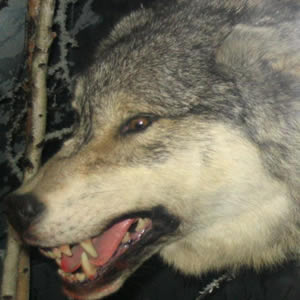
 |
Ice Age end killed the mondo wolvesJune 23, 2007Courtesy of Far North Science 
Modern gray wolf was puppy compared to its larger ancient cousin But these ancient wolves - far more aggressive and much larger than modern gray wolves of North America - went extinct about 12,000 years ago, disappearing along with the other gigantic mammals that roamed the Beringian plains during the ice age. A team of scientists has now shown that these mondo Pleistocene predators were a different previously unknown breed of wolf entirely - so highly specialized for taking down their large prehistoric prey that they could not survive the ecological shift at the end of the Ice Age. We thought possibly they would be related to Asian wolves instead of American wolves because North America and Asia were connected during that time period,” said Jennifer A. Leonard of University of California at Los Angeles, in a release. “That they were completely unrelated to anything living was quite a surprise.” After interpreting skeletal material from 20 prehistoric wolves found in Alaska and far eastern Russia, Leonard and five co-authors described this different species with its own feeding behavior and diet. They looked at genetics, jaw and bone shape, and the chemical traces of their ancient, long-extinct prey. “Our results are surprising as the unique attributes of Alaskan Pleistocene wolves had not been previously recognized and show that wolves suffered an extinction at the end of the Pleistocene,” added co-author Blaire Van Valkenburgh of UCLA. “If not for their persistence in the Old World, we might not have wolves in North America today. Regardless, the living gray wolf differs dramatically from that which roamed Alaska just 12,000 years ago.” A release from the Smithsonian Institution adds more:
The abstract in Current Biology adds:
“The ancient wolves had relatively more massive teeth and broader skulls with shorter snouts, enhancing their ability to produce strong bites,” Van Valkenburgh said in a release. “In addition, the studies of their tooth wear and fracture rate showed high levels of both, consistent with regular and frequent bone-cracking and -crunching behavior.” And so they should. The ancient Alaskan steppe would have curdled the blood of the modern wee predators like brown bears. Lions, short-faced bears and saber-tooth tigers competed with the big wolves. Van Valkenburgh said the loss of these wolves during the end of the ice age suggests that other modern species that specialize may be endangered by global climate change. For instance, a sub-type of modern gray wolf follows migrating caribou across the tundra instead of staking territories like most other wolves. What if global warming replaces the tundra with another type of ecosystem? Will these migratory wolves adapt? “Global warming threatens to eliminate the tundra and it is likely that this will mean the extinction of this important predator,” she said. The same reasoning applies to the polar bear, proposed for an endangered listing due to the projected summer meltdown of sea ice. While polar bears may have evolved from the terrestrial brown bear, the white carnivores have become highly specialized marine predators that would be unable to compete with brown bears on land. |
|